Today we’re going to talk about an avoidants greatest fear.
Now, perhaps the greatest misunderstanding people have about avoidants is that a lot of their avoidant behavior is rooted in anxiety. Dr. John Paul Garrison, who I had the pleasure of interviewing for my podcast was quick to point this out,
I believe his exact words were,
Avoidant behavior is anxiety really, because anxiety is built around the concept of avoidance, we can’t be anxious and not avoid it just comes with the territory.
So, really according to Dr. G. every insecure attachment is firmly rooted in anxiety. It’s just a matter how how the individual copes with the anxiety that informs their attachment style.
- When an anxiously attached person gets anxious they react in anxious ways (begging, pleading, seeking re-assurance)
- When an avoidantly attached person gets anxious they react in avoidant ways (deactivating, ignoring, etc)
So, the real purpose of this discussion is to look at the “triggers” or “fears” that causes the anxiety for an avoidantly attached person.
Ultimately, the thing that is going to frighten an avoidant the most is being in a situation where they feel like their independence is going to be taken away. Usually this occurs when they are in a relationship with an anxiously attached individual. The anxious person seeks re-assurance and the avoidant person deactivates.
But honestly this whole discussion has so much more nuance and complication to it. I’d like to dive in deep so that by the end of it you have a complete understanding of how avoidants operate around their fears.
Alright, Let’s do this.
The Vast Majority Of Our Clients Exes Are Avoidantly Attached
Check this out:
On June 9th, 2021 I ran a poll in our community asking one simple question, “what core attachment style would you classify your ex as?”
The results were pretty eye opening,
Out of the 337 individuals who participated in the poll over 87% believe that they have either a dismissive avoidant ex or a fearful avoidant ex.
And that’s when I knew I had made a major miscalculation. You see, up until that point I had only ever talked about “avoidants” one time. That was in this video right here,
And yet now I have all this data basically saying that close to 90% of the people watching my videos are dealing with avoidants in their relationships.
So I did what any self-respecting content creator would do:
- I bought books.
- Did research.
- And talked to experts
That’s when I started learning something odd about avoidants. Specifically, how they react when they believe they’ve lost you.
The Birth Of The Avoidant Death Wheel
Look at this,
This is my theory on how avoidants, specifically of the dismissive variety experience relationships.
It’s a clockwise circle that can be divided up into eight distinct stages.

What Are Your Chances of Getting Your Ex Boyfriend Back?
Take the quizLet me take a brief moment to take you through each of the stages (I promise this relates to an avoidants fears as well.)
- 1. The avoidant wants someone to love them
- 2. They find someone and enter into a honeymoon period
- 3. Their avoidant core wound gets triggered (typically by their partners anxious core wound)
- 4. The avoidant starts thinking about leaving the relationship.
And here’s where we need to pause at exactly the halfway point of the circle because everything that we’re going to be talking about in this discussion will happen after this point.
- 5. The avoidant actually leaves the relationship
- 6. The avoidant goes through a separation elation phase or mini honeymoon period.
This is where things get incredibly interesting.
Diving In To The Separation Elation Stage Of A Breakup
Look at this, this is research from the wildly popular avoidant attachment website, Free To Attach,
After a relationship ends, people with an avoidant attachment style tend not to show much anxiety or distress, often feeling an initial sense of relief at the relinquishing of obligations and the sense that they are regaining their self-identity, and not tending to initially miss their partner – this is “separation elation” as the pressure to connect is gone.
And this makes total sense when you consider that individuals with an avoidant attachment tend to have core wounds that revolve around a fear of losing their independence.
Let’s pull from Attached to back this up. Attached was written by Amir Levine, and Rachel Heller to help adults find and keep love.
On page 118 they make an interesting assertion,
Avoidants mistake self-reliance for independence
They often equate intimacy with a loss of independence which leads them to pull away when a relationship becomes too close for comfort. But this is really not a true expression of independence but rather a defensive mechanism to protect themselves from perceived threats to their autonomy.
So, when they break up with you rather than grieving the relationship immediately like a normal person, they enter into what I have coined “the mini honeymoon period.”
Look at the position of stage six on our circle. Do you notice how it’s directly across from stage two, the actual honeymoon period. That’s very much by design.
And it’s because of this that I have a theory.
The Honeymoon High Loop
I believe that a lot of Dismissive Avoidants and Fearful Avoidants are caught in this endless loop of chasing what I’m coining as “honeymoon highs.”
Basically, an avoidant falls in love with their partner during stage two of the circle partly because the relationship is new and partly because not a lot of commitment is required. It’s only after more and more commitment in the relationship comes to the forefront that the shine of that relationship kind of wears off for an avoidant.
That’s the inevitable downfall that you see in stages three, four and five.
Stage six of course is where that mini honeymoon period comes into play.
Where the first honeymoon period was more about enjoying love without strings attached, this honeymoon period is about them regaining their independence.
This is why they have separation elation. It feels like they’ve found their long lost friend again and here’s the most wild part. For most avoidants this is an unconscious process that’s probably so embedded in them that they aren’t even aware of it.
Check this out, According to Free to Attach,
Experts in repressing emotions, they do not feel much initially, typically appear to recover quickly after relationships and can move on fast, more comfortable seeking a new pursuit situation. They envisage that a new person could be the solution to their woes. Unable to healthily hold space for their own needs and effectively process guilt, with a new person they once again feel temporarily safe from being overwhelmed by someone else’s and so better able to enjoy connection.
So, theoretically some avoidants will just start the whole circle over again from the beginning with someone new, skipping stages seven and eight and effectively going on the rebound.
Does This Rebounding Strategy Work For Avoidants?
But this got me thinking. Does this work? Is this an effective way to approach grief?
I mean, a simple search on YouTube will kind of tell you what the dating landscape believes,
Rebound relationships don’t work:

What Are Your Chances of Getting Your Ex Boyfriend Back?
Take the quizOr this one,
Or this one,
So… No… It’s commonly believed that rebound relationships are bad.
Yet… research kind of contradicts that theory.
According to the Atlantic, “Rebound relationships” have a terrible reputation.
In one study of participants recovering from breakups said those who’d found a new partner were more confident in their own desirability, more trusting of other people, and less likely to say that they still had feelings for their old partner.
Amy Hackney, a psychology professor at Georgia Southern University, who ran a study on college students studying this.
“The sooner they (college students in her study) began dating someone new, the faster that they felt that they had recovered from that prior relationship,”
So, the common belief that “rebounds don’t work” is kind of false. And it would make sense that avoidants have learned that rebounds are an effective way to deal with their grief which further lends credence to their behavior of jumping from honeymoon to honeymoon.
But here’s where it gets odd.
How Common Are Rebounds Really For Avoidants?
I looked… For hours trying to answer one question.
How common are rebounds?
Sure, I’ve bought into this idea that some avoidants will skip stages seven and eight in our circle.
(The green stages)
But what percentage of them won’t?
But there was nothing. Well, not nothing.
The closest I could find was this sort of sketchy blog looking at divorce statistics that claimed
Approximately 75% of individuals in long-term relationships will experience a rebound after breaking up.
Unfortunately, their references were a little weak. Nevertheless, it gives us something to work with. So, I decided to conduct my own poll in our community.
- 52% claimed they had a rebound relationship
- 48% claimed they haven’t.
So, it’s close to a 50/50 proposition.
Yet, for the (48%) of avoidants who don’t have the luxury of skipping stages seven and eight something more interesting happens to the avoidant psyche.

What Are Your Chances of Getting Your Ex Boyfriend Back?
Take the quizUnderstanding The Importance Of The Phantom Ex Syndrome
Effectively though stages seven and eight are intertwined,
- 7. The breakup is starting to hit me.
- 8. Why can’t I ever find the right person?
Like dominos once stage seven hits them stage eight is inevitably right around the corner.
Let’s pull one last time from Free to Attach,
Avoidants are free to long for an ex once that person is unavailable out of the relationship, and typically out of contact so they are untouched by actual engagement and their deactivation systems aren’t triggered.
At some point during stages seven and eight they’ll get this nostalgic reverie which ultimately leads them to painting you as the “phantom ex.”
Check this out, On page 124 of Attached it says,
One of the consequences of devaluing your romantic relationship is that you often wake up long after a relationship has gone stale, often forgetting all the negative things that annoyed you. You wonder what went wrong? And reminisce lovingly about your long lost partner. This is called the phantom ex phenomenon.
It is the ultimate deactivation strategy for an avoidant.
They will frequently persuade themselves that they are pining for a past love or that the ideal partner is just moments away from entering their lives. This belief in the existence of a “perfect partner” fosters the concept of a “phantom ex” — an idealized, nonexistent figure who perpetually outshines real, present partners. This relentless pursuit of an unattainable ideal often hinders their ability to appreciate and commit to the genuine connections they currently have.
But something about this is bugging me.
No one ever talks about if there’s just one phantom ex or multiple. Once again, I researched. And once again, Nada.
Here’s what I think,
It seems like it’s possible for an avoidant to have multiple phantom exes at different stages of an avoidants life.
- A high school sweetheart
- The first person they slept with
- The first person they lived with
Each new stage of life has the potential to create a new phantom ex. But as I understand the phantom ex phenomenon, it doesn’t always have to be someone that they dated. It could just be ideal. The FOMO on this type of person.
But I’m getting off track. Basically during stages seven and eight they start considering getting back with you having painted you as a phantom ex.
And if that happens, well the whole avoidant death wheel starts over again from stage one.
The Importance Of Convincing An Avoidant That They’ve Lost You
But there is a requirement for all this to happen. They must realize they’ve lost you. You actually need to move on from them.
Let’s pull up that quote from free to attach one more time,
Avoidants are free to long for an ex once that person is unavailable out of the relationship, and typically out of contact.
- Unavailabe out of the relationship (meaning you’ve broken up and may have even moved on or look like you’re moving on)
- Typically out of contact (You aren’t talking)
That’s the only way they’ll feel safe enough to miss you and put you in that phantom ex category.
And therein lies our problem.
Let’s go back to stage six for a moment, the separation elation stage. The worst nightmare for an avoidant is to be overwhelmed with anxiousness from you.
One of the things I didn’t really cover is one of the biggest reasons for why some avoidants will skip stages seven and eight and just honeymoon hunt with someone else.
Well, this is why:
The worst nightmare for an avoidant is:
Anxious behavior. Needing re-assurance. Not giving an avoidant space.
ALL of this stuff actually re-enforces the avoidants decision to leave the relationship. It prolongs their mini honeymoon period.
It’s truly only after an avoidant realizes they’ve lost you that they’re willing to worship you…..
From afar at least.
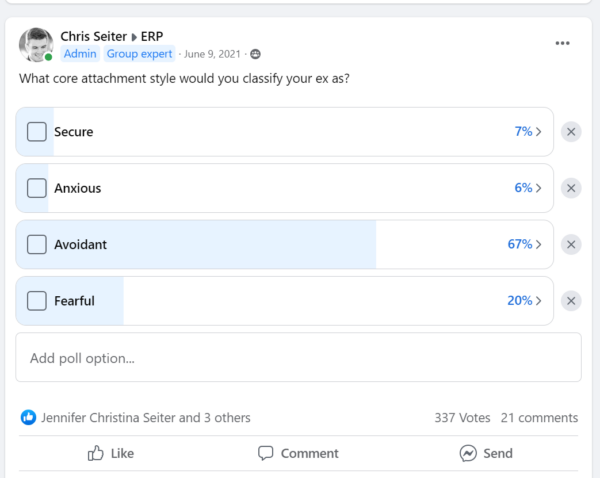
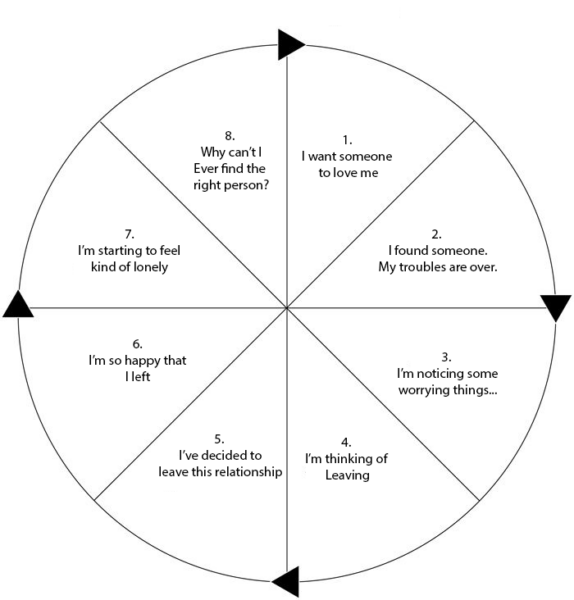
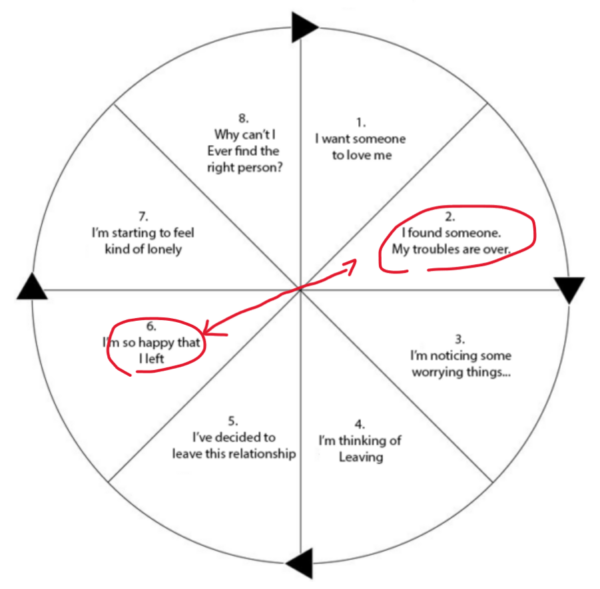
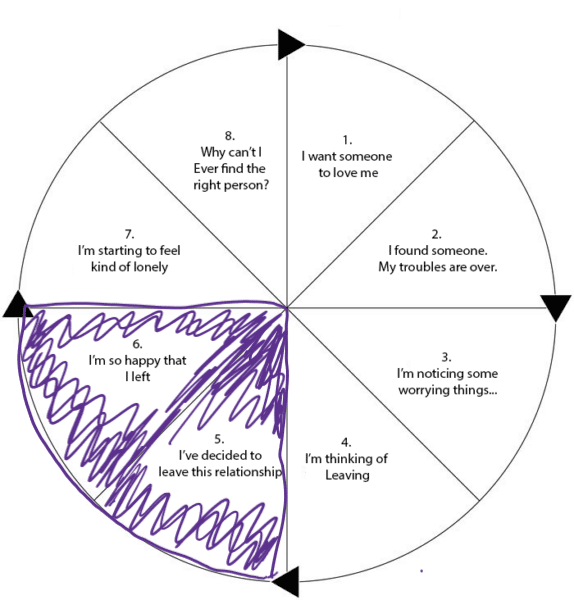
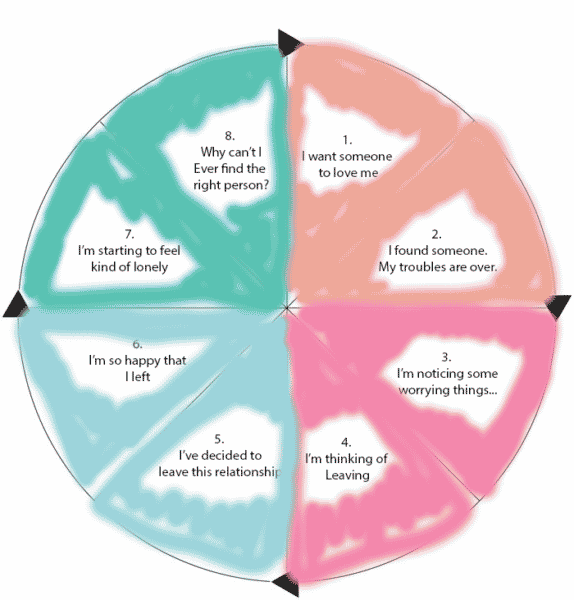
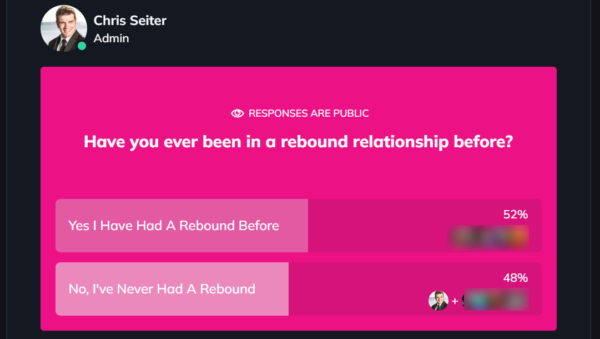
Michelle
September 19, 2024 at 7:58 pm
Thanks for the insight. I (DA) have a peculiar casual “thing” with a male DA. I recognize it in myself, so I have enough forethought to be able to objectively apply principles of space/independence and literally watch how they affect the DA I’m involved with. I usually go no-contact for several days at the first sign of anything in the #3 on the wheel. In an attempt to give him space, I, too, wind up feeling relieved and a bit happy to be the independent spirit I like to be. So, the space is as much for him as it is for me. I can tell if we talk too many days in a row he gets a dismissiveness to him…. not even rude but I can feel his need for space. Even if we’re just texting back and forth. I guess being a DA myself I can pick up on the subtle language. I’ll just ghost him for a week, maybe two. He recharges, I recharge and upon contacting him it’s like wild fun all over again.
Tony
June 2, 2024 at 11:35 pm
How do you go about getting an avoidant partner to open up, embrace the relationship/vulnerability or realise the importance of being there for their partner. As well as getting them to notice their subconscious deactivation strategies.
If you do create another article related to avoidant types, I would like to stay up to date.